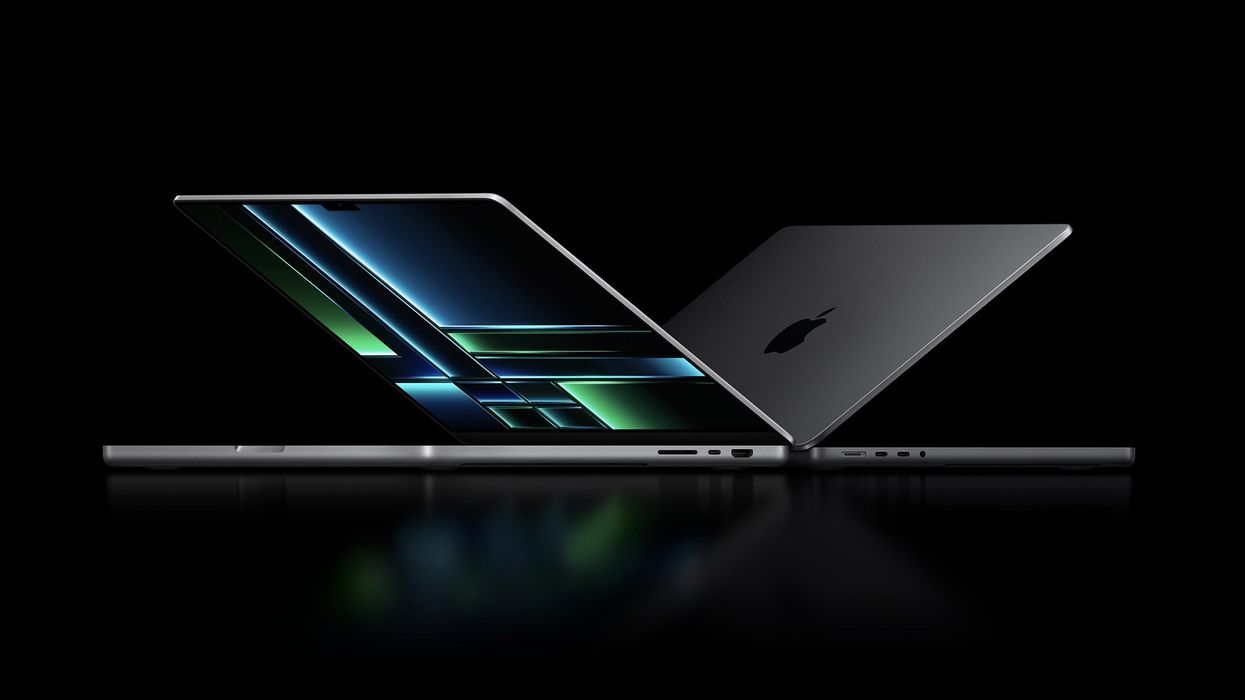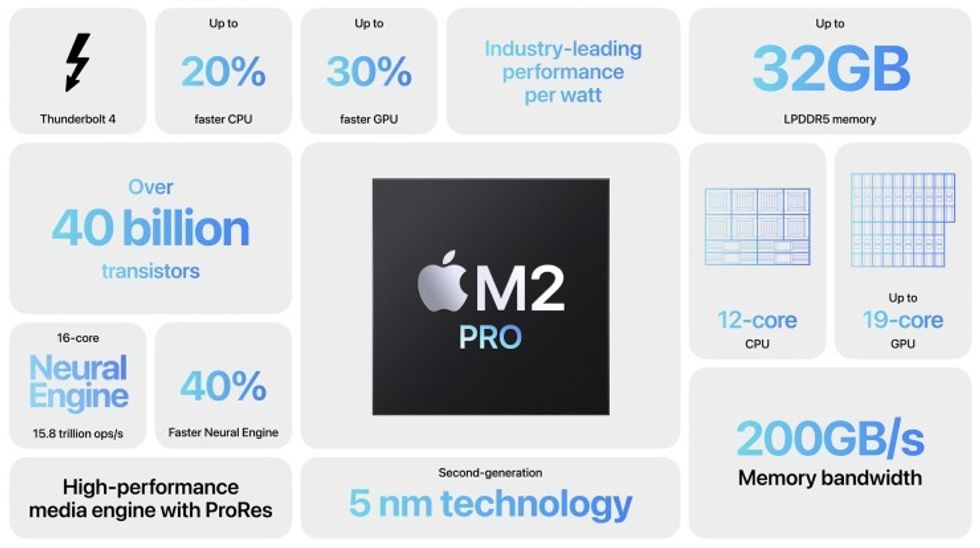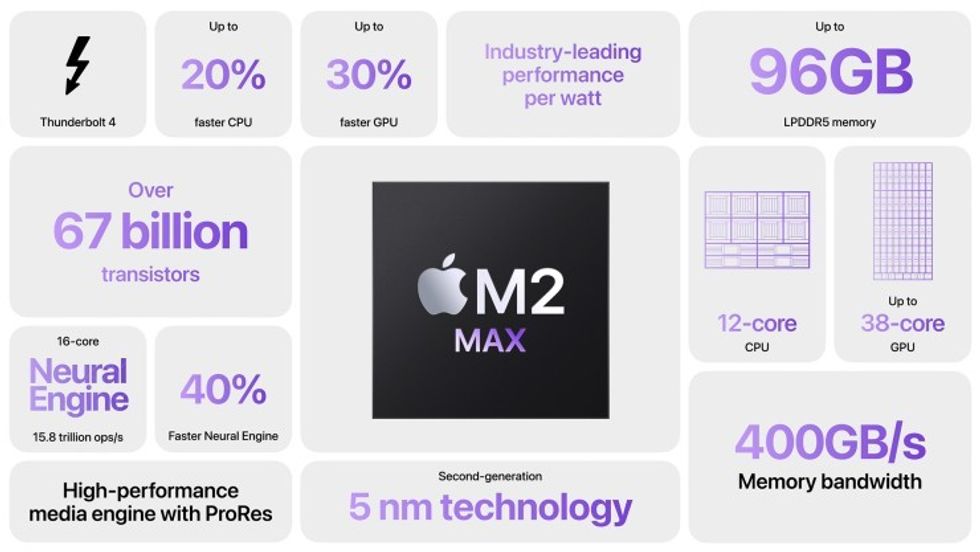The Apple M2 Pro and M2 Max Supercharge the Mac Mini and MacBook Pro
The next generation of Apple Silicon chips gets a boost.

Recently we had news of AMD’s new laptop CPU that some called the Apple Silicon killer. And what did the Cupertino-based company say?
Nothing. Until today...sort of.
To no one’s surprise, the M2 Pro and M2 Max version of the M2 system on a chip (SoC) have finally been revealed. Packed with billions of this and that, the new hardware is an ever-increasing step to higher performance and efficiency.
M2 Pro and M2 Max
The new Apple Silicon SoCs are massive chips even when compared to the baseline M2. When held in one's hand or between the fingers, the Pro chip is about half the size of a postage stamp.

We mention this only to convey the massive engineering feat that is the humble CPU. And Apple has managed to pack a ton of power into the Pro and Max versions of the M2. Both are built on the second generation 5nm technology, the chips carry 12 CPU cores each.
For graphics, the Pro carries a whopping 19 GPU cores, while the Max tops out at 38 GPU cores. That is a modest increase compared to their M1 counterparts.

While the M2 Pro maintains the max unified memory of 32 GB, the M2 Max can now support up to 96 GB. That is up from 64 GB from the last generation.

As we mentioned, both chips make everything faster: faster CPU, faster GPU, and a more powerful Neural Engine. There are more transistors to boot, and the built-in PreRes encode and decode hardware from the last gen SoC.
Are we excited? Yeah, quite a bit. But what we really want to see is these chips in a machine.
Return of the Mac (Mini)
It feels like it has been so long since we have had a Mac Mini update, so using a reference to a 90s hip-hop hit felt right. Overshadowed but its taller sibling, the Mac Studio, the Mini seemed to be left by the wayside. But now, it is getting the M2 love with the baseline SoC and the Pro variant.

Apple is throwing up some impressive numbers as well. The Mini can support three external displays and up to 8K with HDMI. Creatives will also have Wi-Fi 6E and Bluetooth 5.3 as standard and the option for 10 GB Ethernet.
There is also the claim that the M2 model is up to five times faster than the best-selling Windows desktop. This feels like a vague and slightly absurd claim, especially with the drop in desktop GPU prices, but what do we know? We are not in marketing.

Apple is also claiming that these models are 14 times faster than the fastest Intel-based Mac Mini, which we are more inclined to believe. And that is impressive.
The Mac Mini starts at $599 for an M2 SoC, 8 GB of Memory, and 256 GB of storage. That is less impressive as it's not a lot of oomph to meet the standards Apple has set in its announcement. We are also unclear if the 256 GB of storage will suffer the same fate as the other Mac machines.
A Macbook For Pros
The next batch of machines getting the new M2s are the 14-inch and 16-inch Macbook Pros. These machines were updated last generation, bringing back MagSafe and the much-desired SD-card reader.
Unlike the Mac Mini, these two laptops are getting the M2 Pro and M2 Max variants of the new SoC.
However, Apple claims that it has the longest battery life ever in any of their laptops, at 22 hours, which is pretty impressive (the third time for those counting) for a laptop putting out so much power.

Both machines have a Liquid Retina XDR display and can support up to four external displays. And via HDMI, creatives can send a signal to an 8K display. The SDXC reader remains, as well. well.
For comparison, Apple again mentions its Intel machines, with these new laptops able to render six times faster and compile code two and half times faster than the fastest Intel-based MacBook Pro. How complex the code or scene was is unknown, unfortunately. But, Apple did show three real-world use cases.
They were a little "produced," but they did show the MacBook Pros working on three complex projects (from VFX to coding) while only running on battery power.
A Real-Life Comparison
If you have not seen Apple’s announcement, it’s short and sweet, with some nice real-world use cases. However, what are other users saying?
I have recently upgraded from a mid-tier Intel-based Macbook Pro to an M2 Macbook Air. For me, a super light laptop took precedence over the speed that the M2 Pro or Max could bring. While it is not a perfect apples-to-apples comparison to the new products, I do have to say that the jump from Intel to M2 was mind-blowing.
And all from a machine with no fan.

My current machine has had no issues so far even without the fan.
To clarify, I am running Adobe Photoshop daily and DaVinci Resolve once a week. The latter could barely run on my previous Intel Macbook Pro, and now I can edit 4K without proxies.
If you are planning on upgrading from an Intel Mac, then we would completely recommend it. The boost in efficiency (and power) to your workflow will be immense. However, if you are jumping from the M1 family, we would recommend an upgrade only if you can afford it. While the M2 SoCs are powerful, the M1 family is still robust, and you can still run them for years.
The only caveat is that Apple does not always support its first-generation hardware for as long. However, that support is still longer than most competitors, so we are splitting hairs.
Will you be upgrading to the new M2 line? Let us know in the comments!











